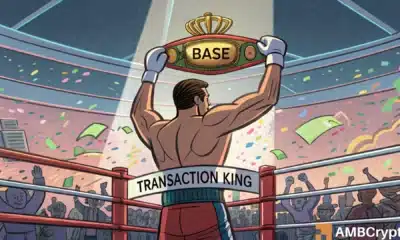Altcoin
These are the reasons behind Solana, Polkadot achieving ‘escape velocity’
There is no doubt that Ethereum was the premier in bringing smart contracts and DeFi to the cryptocurrency ecosystem, firmly establishing its rank as the most used blockchain in the world. Of late, however, several next-generation networks have emerged that sustain themselves on solving many of the problems faced by the older blockchain.
While in the past, many of the tokens on these blockchains were tied to Ether’s price action, it can be observed that they have broken free of Ethereum’s shadow to create their own paths to new all-time highs. While these projects are very popular, their inherent capabilities also effectively rival those of Ethereum.
Crypto-analyst Qiao Wang recently highlighted the same on Twitter, stating that ecosystems like Solana, Polkadot, and Polygon have reached “escape velocity.”
By “escape velocity” I mean there’s an organically growing ecosystem of developers that don’t require brute force marketing / dev acquisition by the core team.
— Qiao Wang (@QwQiao) August 30, 2021
Ethereum’s main setback comes from its own popularity. Due to high demand and user volume, the network has often become congested, leading to transaction fees soaring.
All aboard the Solana hype train
Solana, released just 18 months prior and still in its beta phase, was one of August’s best-performing projects. Gaining by 246.8% in valuation over the past month, the asset smashed resistance levels to score new all-time highs and premiere in the top 10.
Much of this can be attributed to the network’s foray into the profitable world of NFTs. Solana recently launched Degenerate Ape Academy, and high consumer demand led to the asset’s price soaring. It also rode on the back of August’s NFT rally which hit record sales of about $900 million.
Moreover, several projects are also turning to the promising network to build DeFi applications on top of it. Its total value locked in DeFi recently crossed $2 billion, out of an overall $98 billion. By prioritizing smart contracts, Solana has been able to highly leverage the DeFi and NFT spaces in its favor.
The network also boasts the highest speed currently, capable of conducting 50,000 transactions per second, compared to Ethereum’s 30. Moreover, the network claims to solve the ‘blockchain scalability trilemma’ by using the Proof-of History (PoH) consensus. Apparently, this allows it to have high transaction speed, decentralization, and security.
On the other hand, Ethereum is on the way to transitioning towards Proof-of-Stake, having been run on energy-intensive PoW up until now.
Needless to say, many in the community have been receptive to such strides in development. In fact, Santiment recently reported that 10% of all crypto-conversations on Twitter were centered around the network.
? #Solana is making up nearly 10% of #crypto conversations right now as it blasted off to a new #AllTimeHigh of $106.82. As #Bitcoin and most other #altcoins range, volatile & pumping coins like $SOL will continue to intrigue traders looking for action. https://t.co/m0SdRECJHQ pic.twitter.com/LwC26DoyiW
— Santiment (@santimentfeed) August 30, 2021
DOTting the uptrend
Another case in point is Polkadot. The network’s native token DOT saw consistent price appreciation over the year, gaining by over 1,100% in valuation since its low on 20 August last year. In the last month alone, its price grew by almost 80% thanks mainly to updates on its ecosystem.
Much anticipation has surrounded the multichain protocol’s upcoming parachain auctions, one of the main proponents of its positive price action. Through these actions, DeFi projects will compete for community votes in order to obtain one of the limited slots available to launch on the network. The number of projects looking to launch on the network is very high, leading to an increase in the network’s popularity.
As part of the auction process, users stake their tokens to bootstrap funding for the projects receiving these slots. This has increased the token’s buying pressure, while decreasing its circulating supply, leading to an appreciation in price.
Source: Polka Project
The growth in terms of protocols and supporting infrastructure over the past year has been relatively unmatched. As the system continues to onboard new projects through its auctions, this growth is only expected to continue.
